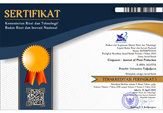The Abilities of Bacillus subtilis and Trichoderma sp. to Suppress Powdery Mildew Disease on Tomato Leaves
Abstract
Keywords
Full Text:
PDF (Bahasa Indonesia)References
Abadi AL. 2003. Ilmu Penyakit Tumbuhan III. Bayumedia Publishing. Malang.
Agrios N. 2005. Plant Pathology 5th Edition. Academic Press.
Asalf B, Onefre RB, Gadoury DM, Peres NA, & Stensvand A. 2021. Pulsed water mists for suppression of strawberry powdery mildew. Plant Disease, 105: 71–77.
Bettiol W, Garibaldi A, & Migheli Q. 1997. Bacillus subtilis for the control of powdery mildew on cucumber and zucchini squash. Bragantia, 56(2): 281–287. https://doi.org/10.1590/S0006-87051997000200007
Bonaterra A, Badosa E, Daranas N, Francés J, Roselló G, & Montesinos E. 2022. Bacteria as biological control agents of plant diseases. Microorganisms, 10(9): 1759. http://dx.doi.org/10.3390/microorganisms10091759
Bovolini MP, Lazarotto M, Gonzatto MP, de Sá, LC & Junior NB. 2018. Preventive and curative control of Oidium Eucalypti in Eucalyptus Benthamii Clonal seedlings. Revista Árvore, 42(5): 420504.http://dx.doi.org/10.1590/1806-90882018000500004
Campbell CL & Madden VL. 2003. Introduction to Plant Disease Epidemiology. Wiley, New York, USA. 532 PP.
Expósito A, García S, Giné A, Escudero N, Herranz S, Pocurull M, Lacunza A, & Sorribas FJ. 2022. Effect of molasses application alone or combined with Trichoderma asperellum T-34 on Meloidogyne spp. management and soil microbial activity in organic production systems. Agronomy, 12(7): 1508. https://doi.org/10.3390/agronomy/12071508
Gao X, Gong Y, Huo Y, Han Q, Kang Z, & Huang L. 2015 Endophytic Bacillus subtilis strain E1R-J is a promising biocontrol agent for wheat powdery mildew. Biomed Res Int.: 462645. https://doi.org/10.1155/2015/462645
Gatinet, A. 2021. Powdery mildew of tomato and its management: A review. International Journal of Plant Pathology and Microbiology, 1(2): 01-04
Gilardi G, Manker DC, Garibaldi A, & Gullino ML. 2008. Efficacy of the biocontrol agents Bacillus subtilis and Ampelomyces quisqualis applied in combination with fungicides against powdery mildew of zucchini. Journal of Plant Diseases and Protection, 115 (5): 208–213. https://doi.org/10.1007/bf03356265
Guetsky R, Shtienberg D, Elad Y, Fischer E, & Dinoor A. 2002. Improving biological control by combining biocontrol agents each with several mechanisms of disease suppression. Phytopathology. 92: 976–985. http://dx.doi.org/10.1094/PHYTO.2002.92.9.976
Hadiwiyono, Widyantoro A, & Widono S. 2013. Antagonisme Bacillus terhadap infeksi layu Fusarium pada bibit pisang hasil kultur jaringan. Agrosains, 15(1): 21-26.
Istifadah N, Ihsani N, & Hartati S. 2018. The potential and application frequency of yeast from tomato and cogon grass leaves to suppress powdery mildew disease in tomato. Jurnal Cropsaver, 1(2): 104-110.
Istifadah N, Fatiyah N, Fitriatin BN, & Djaya L. 2019. Effects of dosage and application frequency of microbial consortium mixed with animal manure on bacterial wilt and late blight diseases of potato. IOP Conference Series: Earth and Environmental Science. 334(1): 1–7. https://doi.org/10.1088/1755-1315/334/1/012038
Istifadah N, Novilaressa PG, Widiantini F, & Hartati, S. 2020. Keefektifan bakteri dan khamir asal air rendaman kompos dalam menekan perkembangan penyakit bercak coklat (Alternaria solani Sorr.) pada tomat. Jurnal Agrikultura, 31(1): 52-60.
Istifadah N, Septiandini A, Hartati S, dan Widiantini F. 2022 Inhibition effects of culture filtrates and volatile compounds of antagonistic microbes isolated from vermicompost and compost teas on the growth of Alternaria solani Sor. in vitro. Jurnal Cropsaver, 5(2): 98-105.
Keinath A, & DuBose V. 2004. Evolution of fungicides for prevention and management of powdery mildew on watermelon. Crop Protection, 23: 35-42. https://doi.org/10.1016/ S0261-2194(03)00165-0
Kim YS, Song JG, Lee IK, Yeo WH, & Yun BS. 2013. Bacillus sp. BS061 Suppresses Powdery Mildew and Gray Mold. Mycobiology, 41(2): 108-11. https://doi.org/10.5941/MYCO.2013 .41.2.108
Meyer SLF, Roberts DP, Chitwood DJ, Carta LK, Lumsden RD, & Mao, W. 2001. Application of Burkholderia cepacia & Trichoderma virens, alone and in combinations, against Meloidogyne incognita on bell pepper. Nematropica, 31: 75-86.
Meyer S. & Roberts D. 2002. Combinations of biocontrol agents for management of plant-parasitic nematodes and soilborne plant-pathogenic fungi. Journal of nematology, 34: 1-8.
Moragrega C, Carmona A, & Llorente I. 2021. Biocontrol of Stemphylium vesicarium and Pleospora allii on pear by Bacillus subtilis and Trichoderma spp.: preventative and curative effects on inoculum production. Agronomy, 11(8): 1455. https://doi.org/10.3390/agronomy11081455
Panstruga R, & Kuhn H. 2019. Mutual interplay between phytopathogenic powdery mildew fungi and other microorganisms. Mol Plant Pathol. 20(4): 463-470. https://doi.org/10.1111/mpp.12771
Poromarto SH, Supyani, Supriyadi, Indriani SA, & Hadiwiyono. 2021. Trichoderma and Bacillus as combined biocontrol agent of moler disease on shallots. Advances in Biological Sciences Research, 13: 92-94.
Poveda J, & Eugui D. 2022. Combined use of Trichoderma and beneficial bacteria (mainly Bacillus and Pseudomonas): Development of microbial synergistic bio-inoculants in sustainable agriculture. Biological Control, 176.105100.10.1016/j.biocontrol.2022.105100.
Semangun H. 2007. Penyakit-penyakit Tanaman Hortikultura di Indonesia (Edisi kedua), Gajah Mada University Press.
Sivapalan A. 1993. Effect of water on germination of powdery mildew conidia. Mycological Research, 97(1): 71–76.
Yendyo S, Ramesh GC, & Binayak RP. 2018. Evaluation of Trichoderma spp., Pseudomonas fluorescens and Bacilus subtilis for biological control of Ralstonia wilt of tomato. F100Research. 6: 2028. https://doi.org/10.12688/f1000research.12448.1
Yigit F, & Dikilitas M. 2007. Control of Fusarium wilt of tomato by combination of Fluorescent Pseudomonas non-pathogen fusarium and Trichoderma harzianum T-22 in greenhouse conditions. Plant Pathology Journal, 6 (2): 159-163. https://doi.org/10.3923/ppj.2007.159.163
DOI: https://doi.org/10.24198/cropsaver.v6i2.49011
Refbacks
- There are currently no refbacks.
Copyright (c) 2023 CROPSAVER - Journal of Plant Protection
2019 © Publisher by Department of Plant Pests and Diseases, Universitas Padjadjaran
In Collaboration With
Centre for Product Development and Partnership Study (Puspromit)
Indonesian Entomological Society (PEI) and
Indonesian Phytopathological Society (PFI)
Chapter Bandung

This work is licensed under a Creative Commons Attribution-NonCommercial 4.0 International License.









